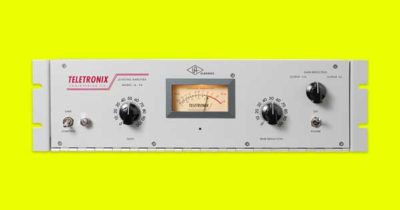How to Master Your Own Mixes, Top 5 LA-2A Compressor Plugins, and More
There was a lot of noise to swim through you were looking for high-quality music production articles and videos this week. However, there were undoubtedly some gems buried in the rough. This Outside Scoop addresses how to master your own mixes, exciting new Eurorack modules, getting the most from recording studio sessions, the top 5 LA-2A compressor plugins, and more.
How to Master Your Own Mixes
Austin Hull from Make Pop Music addresses mastering your own mixes. He walks through his mastering chain and helps unveil some of the mystique behind the process of mastering. This video is an excellent intro to mastering, but if you want to take your mastering abilities a step further, check out the Mastering Demystified video series by Justin Colletti for 4+ hours of in-depth training.
7 Best Eurorack Modules from Superbooth 2019
Will Betts of MusicTech rounds the most exciting Eurorack modules from last week’s Superbooth in Berlin. Some of the list’s top contenders include Future Sound Systems’ Makrow and Stumm, Polyend’s Preset, and the Random Source Serge Resonant EQ. One of my personal favorites is the Polyend Anywhere module that gives you access to a Eurorack power supply that’s USB powered. If you’re big into modular gear, you need to check out this article.
How to Create Cleaner Mixes with Mid/Side EQ Processing
A mid/side EQ allows you to process the middle of your stereo image separately from the sides of your stereo image. This is particularly useful for mastering purposes, especially when you don’t have access to the individual elements of a mix. MusicTechHelpGuy has published a video guide that explains how to use Logic Pro X’s Channel EQ (minimum phase) and Linear Phase EQ to effectively process different parts of your song’s stereo image.
Achieving High RMS Levels and Low LUFS Values
Ian Sheperd, the mastermind behind the youtube channel Production Advice, takes a look at the loudness of the song Xanny off of Billie Eilish’s new album. At some points in the track, the RMS value hits 0. Interestingly, the integrated LUFS value reads out at -9.4, and the short-term LUFS value reads out at -5.7. These values are much lower than you would expect based on the RMS information; watch the full video the learn why this is.
The Power of the Artist Brand
As Aden Russel of EDMProd states, “Digital music sales (MP3s etc.) are decreasing every year, CD sales are decreasing every year (obviously) and streaming has hit an almost plateau in terms of consumption. The only strange exception to this rule is vinyl sales, which seem to be in a revival phase.” He continues on to discuss the effects an over-saturated music market has on both consumers and producers, as well as how investing in your artist brand may allow your business to survive the (unlikely) collapse of streaming services.
How to Get the Most from a Day at a Pro Recording Studio
Studio time isn’t cheap, and this means that every minute counts. Working with a skilled engineer can help ensure that you capitalize on your studio time effectively, but there’s a lot that you can do, as a musician, to make sure that you get the most bang for your buck. Michael Hahn of LANDR says that you should be well rehearsed, make a production plan, ask for a pickup session, show up on time, make use of downtime, allocate time for experimentation, and more.
Melodyne vs. Auto-Tune: 4 Major Differences
Melodyne and Auto-Tune are undoubtedly two of the most notorious pitch correction software on the market right now. Most people usually buy one or the other, but owning both does have its benefits; they aren’t quite as similar as you may think. Sundown Studios explains that the main differences are real-time (Auto-Tune) vs. offline (Melodyne) tuning and monophonic (Auto-Tune) vs. polyphonic (Melodyne) processing. Read the full article to learn about recommended approaches to pitch correction with each device, and which software should be used for live performance vs. studio work.
Mix the Most Important Section First
Mixing the drop, or chorus of your song, before other sections will set you up for success. The fullest part of your arrangement is the hardest to mix due to masking. If you can get the climax of your song sounding great, the emptier sections of your music will come together quickly. Watch the full video with Graham Cochrane of Recording Revolution for audio examples demonstrating this technique in action.
Top 5 LA-2A Compressor Plugins
The renowned LA-2A is a classic compressor with a rich, warm tone. It’s known to be quite musical, making it a wildly popular choice when trying to achieve a natural sound. This plugin roundup by Brad Pack of Pro Audio Files demonstrates how 5 different LA-2A plugin compressors sound on drums, bass, and vocals. Unsurprisingly, UAD’s Teletronix LA-2A made the top of the list, but I was blown away by the quality Native Instrument’s VC 2A as well. Each compressor sounded quite different, so they definitely each bring their own value to the table.
Charles Hoffman is a Mixing and Mastering Engineer at Black Ghost Audio. After graduating from the University of Manitoba with an English degree, Charles completed his education at Icon Collective in Los Angeles, CA.
Please note: When you buy products through links on this page, we may earn an affiliate commission.








[…] http://sonicscoop.com/2019/05/18/how-to-master-your-own-mixes-top-5-la-2a-compressor-plugins-and-mo… How to Master Your Own Mixes, Top 5 LA-2A Compressor Plugins, and More […]